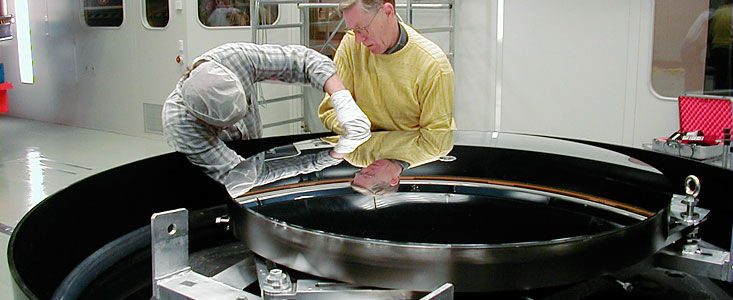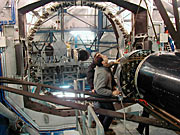Comunicato Stampa
"First Light" Approaches for Fourth VLT Unit Telescope
YEPUN's Secondary Mirror Now in Place
28 Agosto 2000
These days, the ESO staff at Paranal is having a strong feeling of "déja-vu". Only seven months after the third 8.2-metre VLT Unit Telescope, MELIPAL, achieved "First Light", this crucial moment is now rapidly approaching for YEPUN , the fourth and last of the giants at the ESO observatory.
Following successful coating with a thin layer of aluminium in early June 2000, the 8.2-metre primary Zerodur mirror (M1) was placed in its supporting cell and safely attached to the mechanical structure of YEPUN on July 31.
On August 26, the 1.1-metre M2 Beryllium Mirror for YEPUN was coated. Again, this delicate operation went very well and the measured reflectivity was excellent, about 91%. The M2 mirror and its support were then assembled and successfully installed at the telescope on Sunday, August 27.
Before the optical mirrors were installed, and with dummies in their place, careful tests were made of most telescope functions. In particular, this included accurate balancing of the 450-tonnes telescope frame on its hydrostatic oil bearings, as well as precise adjustment of all motions. It now remains for the ESO engineers to do the final performance optimization of the entire telescope.
The work on the fourth telescope has been particularly noticeable because a large proportion of the assembly, integration, tuning and testing was organised and executed by ESOs young group of capable engineers and technicians. As the engineering staff at Paranal has grown and during the earlier work on the first three telescopes, they have been acquiring the necessary expertise to autonomously integrate and maintain the 8.2-metre telescopes.
During the coming "First Light" observations, light from the selected celestial objects will be registered by the VLT Test Camera at the Cassegrain Focus. This comparatively simple instrument was also used for the consecutive "First Light" events for ANTU (May 1998), KUEYEN (March 1999) and MELIPAL (January 2000). It is mounted on the telescope's optical axis within the M1 Mirror Cell, just behind the main mirror.
It is planned to make one or more of these first images available on the web soon thereafter.
Sul Comunicato Stampa
| Comunicato Stampa N": | eso0027 |
| Legacy ID: | Photo 21a-b/00 |
| Nome: | Mirror |
| Tipo: | Unspecified : Technology : Observatory : Telescope |
| Facility: | Very Large Telescope |
Our use of Cookies
We use cookies that are essential for accessing our websites and using our services. We also use cookies to analyse, measure and improve our websites’ performance, to enable content sharing via social media and to display media content hosted on third-party platforms.
ESO Cookies Policy
The European Organisation for Astronomical Research in the Southern Hemisphere (ESO) is the pre-eminent intergovernmental science and technology organisation in astronomy. It carries out an ambitious programme focused on the design, construction and operation of powerful ground-based observing facilities for astronomy.
This Cookies Policy is intended to provide clarity by outlining the cookies used on the ESO public websites, their functions, the options you have for controlling them, and the ways you can contact us for additional details.
What are cookies?
Cookies are small pieces of data stored on your device by websites you visit. They serve various purposes, such as remembering login credentials and preferences and enhance your browsing experience.
Categories of cookies we use
Essential cookies (always active): These cookies are strictly necessary for the proper functioning of our website. Without these cookies, the website cannot operate correctly, and certain services, such as logging in or accessing secure areas, may not be available; because they are essential for the website’s operation, they cannot be disabled.
Functional Cookies: These cookies enhance your browsing experience by enabling additional features and personalization, such as remembering your preferences and settings. While not strictly necessary for the website to function, they improve usability and convenience; these cookies are only placed if you provide your consent.
Analytics cookies: These cookies collect information about how visitors interact with our website, such as which pages are visited most often and how users navigate the site. This data helps us improve website performance, optimize content, and enhance the user experience; these cookies are only placed if you provide your consent. We use the following analytics cookies.
Matomo Cookies:
This website uses Matomo (formerly Piwik), an open source software which enables the statistical analysis of website visits. Matomo uses cookies (text files) which are saved on your computer and which allow us to analyze how you use our website. The website user information generated by the cookies will only be saved on the servers of our IT Department. We use this information to analyze www.eso.org visits and to prepare reports on website activities. These data will not be disclosed to third parties.
On behalf of ESO, Matomo will use this information for the purpose of evaluating your use of the website, compiling reports on website activity and providing other services relating to website activity and internet usage.
Matomo cookies settings:
Additional Third-party cookies on ESO websites: some of our pages display content from external providers, e.g. YouTube.
Such third-party services are outside of ESO control and may, at any time, change their terms of service, use of cookies, etc.
YouTube: Some videos on the ESO website are embedded from ESO’s official YouTube channel. We have enabled YouTube’s privacy-enhanced mode, meaning that no cookies are set unless the user actively clicks on the video to play it. Additionally, in this mode, YouTube does not store any personally identifiable cookie data for embedded video playbacks. For more details, please refer to YouTube’s embedding videos information page.
Cookies can also be classified based on the following elements.
Regarding the domain, there are:
- First-party cookies, set by the website you are currently visiting. They are stored by the same domain that you are browsing and are used to enhance your experience on that site;
- Third-party cookies, set by a domain other than the one you are currently visiting.
As for their duration, cookies can be:
- Browser-session cookies, which are deleted when the user closes the browser;
- Stored cookies, which stay on the user's device for a predetermined period of time.
How to manage cookies
Cookie settings: You can modify your cookie choices for the ESO webpages at any time by clicking on the link Cookie settings at the bottom of any page.
In your browser: If you wish to delete cookies or instruct your browser to delete or block cookies by default, please visit the help pages of your browser:
Please be aware that if you delete or decline cookies, certain functionalities of our website may be not be available and your browsing experience may be affected.
You can set most browsers to prevent any cookies being placed on your device, but you may then have to manually adjust some preferences every time you visit a site/page. And some services and functionalities may not work properly at all (e.g. profile logging-in, shop check out).
Updates to the ESO Cookies Policy
The ESO Cookies Policy may be subject to future updates, which will be made available on this page.
Additional information
For any queries related to cookies, please contact: pdprATesoDOTorg.
As ESO public webpages are managed by our Department of Communication, your questions will be dealt with the support of the said Department.


